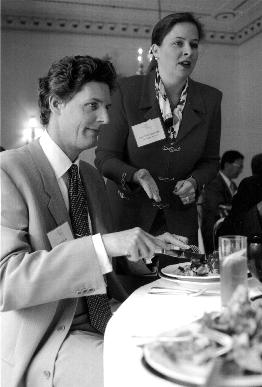 |
  |
  |
 
|
 Monday, September 8, 1997 |
| Business class | |
| An etiquette educator says you may find your career at a crossroads if you don’t know which fork—dinner, fish, or salad—to take |
By Alisa Valdés GLOBE STAFF |

Auto dealer Ernie Boch Jr. participates in a seminar on etiquette for professionals. Boch and five of his managers attended to polish their dining skills and "room working" talents. |
Without consulting Miss Manners, can you tell what’s wrong with this scene? A young woman – we shall call her Mary – walks into a cocktail party and dinner function for the firm where she has just been hired as an account executive. Mary wears a sleeveless black dress, with pearls, dangling diamond earrings, and black flats. She picks her name tag up off the table and pins it on the left of her dress front. Next, Mary spots the man who sits next to her in the office – we’ll call him John – and waves, gesturing to indicate that she will be over soon as she grabs a drink. With her gin and tonic in her right hand, Mary heads toward John, who is conversing with an executive. John introduces the executive to Mary. They shake hands. Mary looks the executive up and down, smiles and says “hello.” John makes a toast to Mary’s new job. Mary, John and the executive raise their glasses, and all take sips. When dinner is announced, Mary is the first to sit down. She immediately puts the napkin in her lap. If you counted nine corporate etiquette violations by Mary, and one by John, you were right (see next page to learn which rules were broken.) If you didn’t spot them all, you are jeopardizing your career according to Amy Mills Tunnicliffe, director of a workshop called “Finishing the Fortune 500™: |
 |
|
Mary’s Mistakes
...and John’s He flubbed the introduction. It is important to introduce the person of lesser status to the higher-ranking person, not the other way around. |
The one-day course is offered by Tunnicliffe’s Hingham company, a finishing school called The Proper Manner. The course costs $395 a person and covers everything from “Perfectly Proper Introductions” to “Top 10 Signs of a Savvy Diner.” A recent workshop held at the Ritz-Carlton hotel in Boston drew executives from the automotive, beer, telecommunications, travel, and hotel industries. ••• Etiquette for everyone Tunnicliffe, age “30-something,” was raised by “very proper parents” in southern Illinois and majored in Journalism at the University of Missouri. In 1991, she left a lucrative marketing and advertising career in the Boston area to teach etiquette to children. But when parents began discreetly asking for tips, Tunnicliffe knew there was also a need for a manners class for adults. “This is one of the only countries in the world where you can actually go from working in the mail room to being the company president,” said Tunnicliffe. “You may learn how to dress the part, but it’s the little details that give you away…. Hopefully, you had these behaviors modeled for you as a child. But not all of us were that lucky, and it’s never too late to learn them.” While emphasizing etiquette and protocol may seem frivolous in today’s dress-down world, research indicates that humans remain a shallow bunch impressed by poise and good manners. Like it or not, said Tunnicliffe, careers are made—and ruined—every day, based not on work but on appearances. |
This is old news to Ernie Boch Jr., vice president of his family’s successful auto dealership. A good salesperson is a master of appearances, he said during the workshop, where he was a participant. Boch brought five managers to Tunnicliffe’s recent workshop at the Ritz-Carlton, in order to burnish their dining skills and his “room working” talents. “We are invited to corporate dining situations all the time,” said Boch. “And your best salesperson is not always your most polite guest.” For those who sneer at etiquette, consider that Tunnicliffe acknowledged during the workshop that she would not have hired a particular intern had she known about his lack of refinement in the dining room. “He had these enormous feet that he just wrapped around the backs of his chair legs, and he ordered linguine, of all things. He just twirled it and twirled it, and when he couldn’t twirl it onto his fork, he simply lifted it up in one long string, threw his head back and lowered it into his mouth. That is not the kind of person you want representing your company.” ••• |
|
Which fork to take To practice protocol, workshop participants were seated at tables and taught to decipher complex place settings during a multi-course meal—how to tell a fish fork from a salad fork, for example. They also learned how to use finger bowls properly and were treated to the story of former President George Bush and the finger bowl: Upon seeing that an ignorant dinner guest was drinking the water from his finger bowl, Bush lifted his bowl and drank too, presumably to make the guest feel at ease. “I have met many people,” said Tunnicliffe, “and I have to say that George Bush was the most poised. The person with the best manners is always the person whose manners you notice the least.” If there was a single theme to the Tunnicliffes’ workshop, it was that fitting in is the key to corporate success. Work is theater, a section in the workshop guidebook says. “Wear the appropriate costume.” “We judge a person and form a solid opinion within the first 60 seconds of meeting someone,” Tunnicliffe’s associate during the workshop, Jane Hight McMurry, said during her session on nonverbal communication skills. “Research has shown that 93 percent of our communication is nonverbal, or body language. Words account for only 7 percent of the impact of your message.” ••• Common sense, and more McMurry runs a company similar to Tunnicliffe’s, in North Carolina. A former debutante, McMurry gave many suggestions that are sensible enough: groom well, make eye contact, smile, keep hands out of pockets, nod, and don’t crack your knuckles or twirl your hair. Other suggestions, however, are more surprising: get rid of scars and birthmarks with laser surgery, have plastic surgery to "correct" aging and, for women, dye gray hair and wear hair no longer than shoulder length. "It's not fair, we know that," said McMurry. "Life is not fair. And I am not advocating plastic surgery or dyeing your hair. My mother-in-law has beautiful white hair, like Barbara Bush, who is a great example of a successful wife. We are just saying that the research very clearly shows that once a woman starts to look old, she is perceived as tired and less effective, no matter how good the work is that she is doing...And it is proven that women who make it to the top have hair at or above shoulder length." |
 "We are invited to corporate dining situations all the time," said Boch (above), with trainer Amy Mills Tunnicliffe. |
| ‘The person with the best manners is always the
person whose manners you notice the least.’ AMY MILLS TUNNICLIFFE The Proper Manner |
